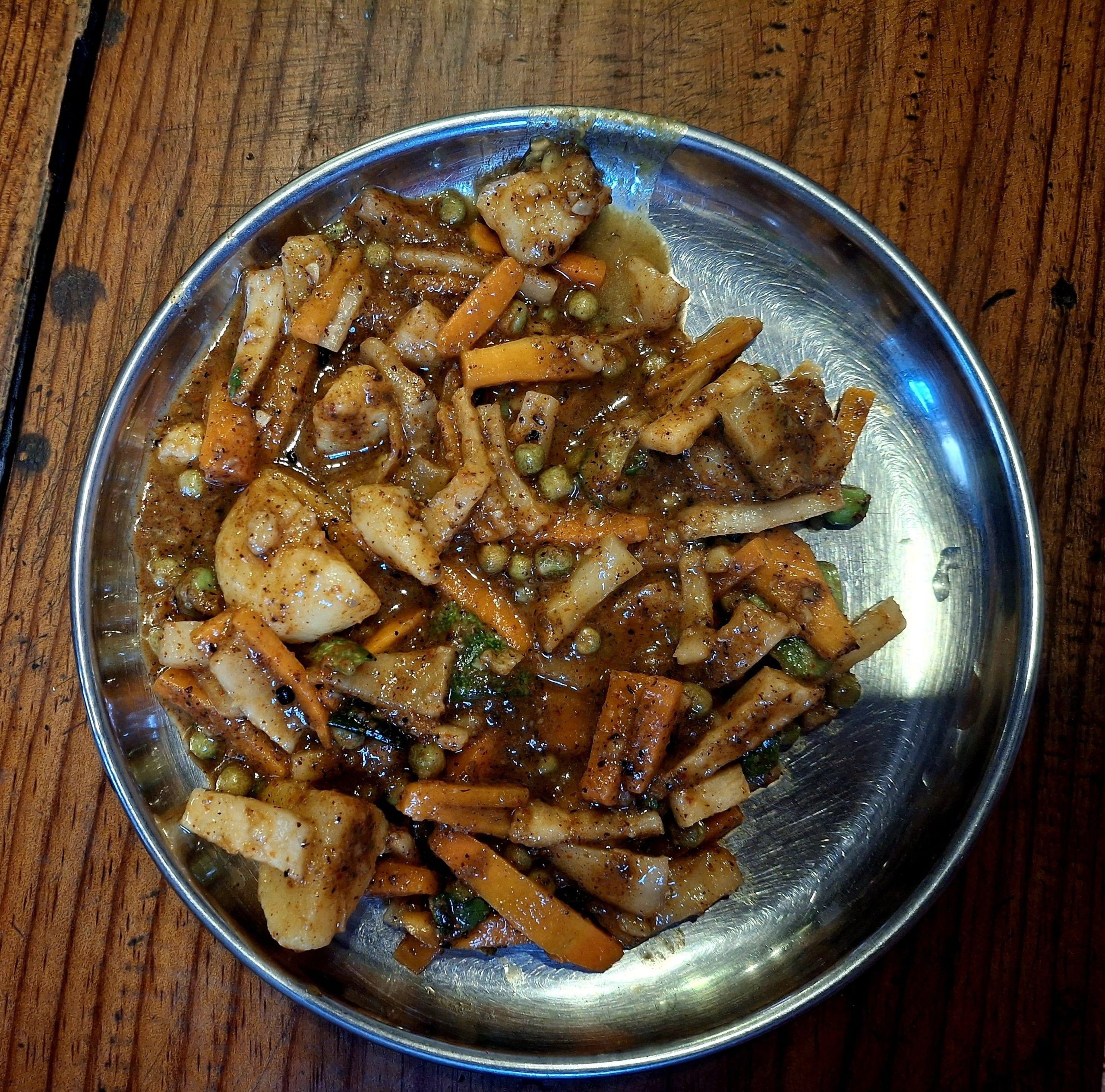Newari Aachar

Newari Aachar, a cornerstone of Nepal’s culinary heritage, is renowned for its rich diversity and deep cultural significance. Among its many treasures is the vibrant and flavorful aachar (pickle), a staple that elevates meals with its tangy, spicy, and refreshing qualities. This blog explores the traditional Newari aachar made with radish, carrot, and cucumber, delving into its cultural importance and sharing an authentic recipe to bring this Nepali delight to your kitchen.
Cultural Importance of Newari Aachar
In Newar culture, food is more than sustenance—it’s a celebration of identity, community, and tradition. Aachar holds a special place in Newari cuisine, often served as a side dish during daily meals, feasts, and festivals. The inclusion of pickles in a Newari meal, such as the Newa Thali or Jho Bhoya (a traditional feast), complements the array of dishes like rice, lentils, vegetables, and meats, balancing flavors and aiding digestion.
Aachar is particularly significant during Newari feasts, where it is served in specific phases alongside beaten rice, meats, and yogurt, symbolizing abundance and hospitality. The radish-based sisha fusa (pickled vegetables including radish, carrot, and cucumber) is valued for its digestive properties, often served toward the end of a feast to cleanse the palate and settle the stomach. The use of seasonal and locally sourced ingredients, like radish and carrots in winter, reflects the Newar emphasis on sustainability and harmony with nature.
Beyond its culinary role, aachar embodies the Newar community’s ingenuity in preserving food. Fermentation and pickling techniques, passed down through generations, ensure that seasonal produce can be enjoyed year-round, a practice rooted in the fertile Kathmandu Valley. This preservation aligns with the Newar philosophy of adapting meals to climatic and nutritional needs, making aachar both a practical and symbolic dish.
The cultural significance of Newari aachar extends to its potential recognition as part of UNESCO’s Intangible Cultural Heritage list. Efforts are underway to document its recipes, rituals, and social customs, highlighting its role in fostering community cohesion and preserving local traditions. By preparing and sharing aachar, Newars strengthen familial and communal bonds, making it a vital thread in the fabric of their cultural identity.
Recipe: Newari Aachar
This recipe for Newari-style aachar combines the crisp textures of radish, carrot, and cucumber with the bold flavors of mustard oil, sesame, and Nepali spices. It’s simple to prepare and can be stored for weeks, making it a perfect addition to your meals.
Ingredients (Serves 4-6)
-
Vegetables:
-
1 large daikon radish (about 300g), peeled and cut into thin 2-inch batons
-
2 medium carrots (about 200g), peeled and cut into thin 2-inch batons
-
1 medium cucumber (about 150g), cut into thin 2-inch batons
-
-
Spices and Seasonings:
-
2 tbsp sesame seeds (black or white), roasted and coarsely ground
-
1 tsp cumin seeds
-
1 tsp coriander seeds
-
1/2 tsp fenugreek seeds
-
1 tsp turmeric powder
-
1 tsp red chili powder (adjust to taste)
-
2 green chilies, slit or chopped (adjust to taste)
-
1 tbsp salt (for salting vegetables)
-
1 tsp salt (for final seasoning)
-
-
Other:
-
1/2 cup mustard oil
-
3 tbsp rice vinegar or lemon juice (for sourness and preservation)
-
1 tbsp chopped cilantro (optional, for garnish)
-
Instructions for Newari Aachar
-
Prepare the Vegetables:
-
Wash, peel, and cut the radish, carrots, and cucumber into thin, uniform 2-inch batons.
-
Place the vegetables in a large bowl, sprinkle with 1 tbsp salt, and mix well. Cover and let sit for 1 hour to draw out excess water, preventing a watery pickle.
-
Drain the liquid using a colander and spread the vegetables on a clean cloth or tray. Sun-dry for 2-3 hours (or place under a fan) to remove remaining moisture. This step enhances shelf life and flavor.
-
-
Toast and Grind Spices:
-
In a dry pan over low heat, roast mustard seeds, cumin seeds, coriander seeds and fenugreek seeds for 1-2 minutes until aromatic. Let cool, then grind coarsely.
-
Separately, roast sesame seeds until they pop, then grind coarsely to a powder.
-
-
Prepare Mustard Oil:
-
Heat 1/2 cup mustard oil in a pan over medium-high heat until it begins to smoke. Turn off the heat and let the oil cool completely to remove its raw smell and enhance flavor.
-
-
Mix the Aachar:
-
In a large mixing bowl, combine the dried vegetables, ground spice mix, sesame powder, turmeric, red chili powder, timmur (if using), green chilies, and 1 tsp salt.
-
Pour in the cooled mustard oil and rice vinegar (or lemon juice). Mix thoroughly to ensure the vegetables are well-coated.
-
-
Serve:
-
Garnish with chopped cilantro (optional) and serve as a side dish with rice, dal, roti, or during a Newari feast with beaten rice and meats.
-
Tips for Success
-
Vegetable Ratios: Adjust the proportion of radish, carrot, and cucumber to your preference. For a radish-heavy aachar, increase the radish quantity.
-
Spice Level: Modify the chili powder and green chilies to suit your heat tolerance. Timmur adds a unique, tongue-tingling flavor but is optional.
-
Storage: Ensure the jar and utensils are completely dry to prevent mold. If the oil level drops, top up with more cooled mustard oil.
-
Variations: Add sliced ginger or soaked green peas for extra flavor, as seen in some Newari recipes.
Conclusion
Newari aachar with radish, carrot, and cucumber is more than a pickle—it’s a testament to the Newar community’s culinary artistry and cultural heritage. Its tangy crunch enhances meals while embodying centuries-old traditions of preservation and sustainability. By preparing this aachar, you’re not just savoring a delicious condiment but also connecting with the vibrant culture of Nepal’s Kathmandu Valley. Try this recipe at home and share it with loved ones to experience the joy of Newari feasting!
Have you tried making aachar before? Share your thoughts or variations in the comments below!
